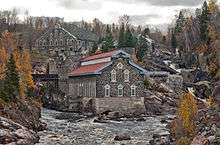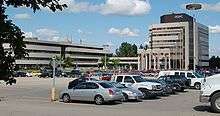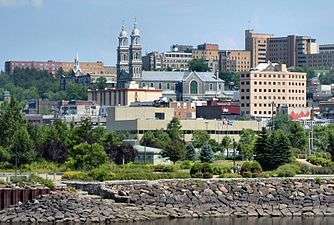Chicoutimi
| Chicoutimi | |
|---|---|
| Borough | |
|
Downtown Chicoutimi | |
|
Nickname(s): Queen of the North, Saguenay Queen, Saguenay metropolis, Saguenay kingdom capital, Conventions city (Reine du Nord, Reine du Saguenay, Métropole du Saguenay, Capitale du royaume du Saguenay, Ville des congrès) | |
 | |
| Country | Canada |
| Province | Quebec |
| Region | Saguenay–Lac-Saint-Jean |
| City | Saguenay |
| Government | |
| • Borough president | Jacques Fortin |
| Website | Borough Council of Chicoutimi |
Coordinates: 48°25′40″N 71°03′33″W / 48.42778°N 71.05917°W Chicoutimi /ʃᵻˈkuːtᵻmi/ is the most populous borough (arrondissement) of the city of Saguenay in Quebec, Canada.
Chicoutimi was founded by European Canadians as a city in 1842 at the confluence of the Saguenay and Chicoutimi rivers. The name Chicoutimi means the end of the deep water in Innu-aimun. During the 20th century, it became the main administrative and commercial centre of the Saguenay–Lac-Saint-Jean region. In 2002 it merged into the new city of Saguenay and forms the heart of the 5th-largest urban area of Quebec province. It is home to the University of Quebec at Chicoutimi (Université du Québec à Chicoutimi).
At the 2011 census, it had a total population of 66,547.[1] The borough was formed in 2002 from the merger of the former cities of Chicoutimi, Laterrière, and part of the former township of Tremblay.
History

.jpg)

What was ultimately to become the centre of the borough of Chicoutimi was first settled by French colonists in 1676 as a trading post in the fur trade. At that time, the Saguenay and the Chicoutimi rivers had been used as waterways by the Montagnais tribes for centuries. The name Chicoutimi means the end of the deep water in the Innu language. After the British took over rule of Lower Canada, the Chicoutimi trading post operated until 1782. By that time, the fur trade had moved mostly further west of the Great Lakes.
The city of Chicoutimi was officially incorporated in 1845 as a municipality by Peter McLeod. He was a Métis timber contractor who built a sawmill here in 1842. The town was designated in 1855 as the seat of Chicoutimi County and the seat of the Roman Catholic Diocese of Chicoutimi in 1878.
With the arrival of the Canadian National Railway in 1893, Chicoutimi had increased growth of its pulp and paper industries, particularly in mechanical pulp production. The Chicoutimi Pulp Co. was founded in 1896 and backed by French-Canadian investors. The Chicoutimi Pulp Mill became the biggest producer of mechanical pulp in Canada by 1910.
Since the Great Depression, the city has become an administrative and commercial centre. New centers of education and culture developed, with the Conservatoire de musique de Saguenay founded in Chicoutimi in 1967, and the Université du Québec à Chicoutimi founded in 1969. The city also played host to the Quebec Summer Games in 1972.
In the municipal amalgamations of 1976, Chicoutimi annexed the neighbouring towns of Chicoutimi-Nord and Rivière-du-Moulin. In a much larger round of Municipal reorganization in Quebec in 2002, the cities of Chicoutimi, Jonquière, La Baie, Lac-Kénogami, Laterrière, Shipshaw and part of Tremblay merged to form the new city of what was named as Saguenay.[2] Chicoutimi became a borough of Saguenay.
During the summer of 1996 a record rainfall in the region caused major flooding in the downtown, as well as outlying areas. Dams and bridges across the region were overwhelmed. The total cost of the disaster was recorded as 1.5 billion Canadian dollars. It also claimed seven lives and destroyed many bridges.
Chicoutimi's sister city was Camrose in Alberta; it became Saguenay's sister city.
Geography and cityscape
Chicoutimi is located in Saguenay–Lac-Saint-Jean region on the western end of the Saguenay Fjord; most of the borough, including the downtown section, is on the south shore of the Saguenay River. It is the geographical centre of the city of Saguenay; the Jonquière and La Baie boroughs adjoin on the west and east sides. Chicoutimi is about 200 kilometres (120 miles) north of Quebec City and 126 kilometres (78 miles) northwest upriver from Tadoussac, at the confluence of the St. Lawrence River. The former cities of Chicoutimi borough are: Chicoutimi, Laterrière, Canton-Tremblay, Chicoutimi-Nord and Rivière-du-Moulin. They have maintained their names as wards in the amalgamated city.
The landscape of Chicoutimi consists of hills, valleys and plains, with the terrain becoming steeper near the Saguenay River. Its two major physical features are the Saguenay Graben, a rift valley of the Laurentian Highlands in which the city spreads, and the Saguenay Fjord, the glacier-carved steep shores of the Saguenay River. Mount Valin at 3,215 feet (980 metres) is the tallest mountain of the region, and overlooks Chicoutimi 30 kilometres (19 miles) north-east. The Chicoutimi, Du Moulin and Valin rivers all empty in the Saguenay river in Chicoutimi.
Culture

Sports
The city has been home to the QMJHL's Chicoutimi Saguenéens since 1973. They play at the Centre Georges-Vézina.
Professional hockey players from Chicoutimi
Law and government
Residents of Chicoutimi are represented by three tiers of government. The first are the city councillors elected from single-member districts and the mayor elected at-large for the city of Saguenay. At the provincial tier, two elected members serve in the National Assembly of Quebec for the provincial ridings of Chicoutimi and Dubuc. The federal representation consists of a members of parliament serving in the Parliament of Canada for the federal riding of Chicoutimi—Le Fjord.
Education
International relations
Twin towns – Sister cities
Chicoutimi is twinned with:
Notable people
- Johnny Gagnon
- John Kricfalusi
- René Simard
- Charles Sirois
- Georges Vézina
- Arthur Villeneuve
- Christine Young[4]
According to the website of the Phoenix Coyotes, an NHL hockey team in the United States, the team's mascot, Pierre the Fanatic Hockey Snowman, comes from Chicoutimi.[5]
References
- ↑ Service des systèmes et technologies de l'information de la Ville de Saguenay et Promotion Saguenay. "Population, statistiques et territoire".
- ↑ ISQ - Redirection
- ↑ "National Commission for Decentralised cooperation". Délégation pour l’Action Extérieure des Collectivités Territoriales (Ministère des Affaires étrangères) (in French). Retrieved 2013-12-26.
- ↑
- ↑ Phoenix Coyotes. Coyotes.nhl.com (2013-04-27). Retrieved on 2013-07-12.
External links
| Wikimedia Commons has media related to Chicoutimi. |
| Wikivoyage has a travel guide for Chicoutimi-Jonquière. |
- (French) Borough Council of Chicoutimi
- (French) Municipality of Chicoutimi (Archive)
